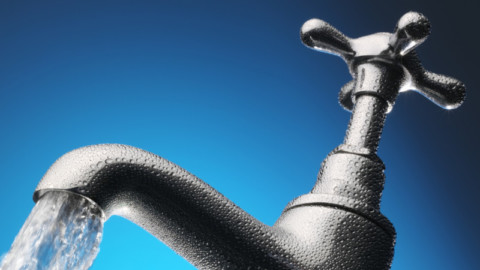Barwon Water’s new Managing Director, Tracey Slatter, has only been in the role since the start of 2017, but she is already making plans to help address major issues in the region, including population growth, water security, liveability, and the effects of climate change. Here’s how she plans to work with the community to shape the utility’s future direction.
Ms Slatter is stepping into the top job at Victoria’s largest regional urban water corporation with a range of previous leadership experience. She has been CEO of the Colac Otway Shire, and the City of Port Phillip, the Head of Claims at the Transport Accident Commission in Geelong, and has held numerous executive positions within the Victorian Government.
Ms Slatter said she was excited to join Barwon Water at a time when the Geelong region is going through a transition in its economy, from one that was primarily a manufacturing-based economy, to a more service industry, technology and new manufacturing-driven one.
“Organisations like Barwon Water really have to play a strong role in helping to lead that transition, particularly with water being so critical to the economy and liveability. I thought it was a great time to come back to the region, and to work in an organisation that has a critical role to play.
“I think my breadth of leadership, coming into an organisation like Barwon Water at a time of change, is proving to be a real strength. I’m finding that I’m drawing on the experiences that I’ve had in all of those organisations to help this organisation shape its future direction.”
Community engagement key for future policy
Ms Slatter said that while Barwon Water is currently in a relatively strong position, she hopes to further build on its strengths through a focus on community engagement.
“Barwon Water is in a strong position. It’s been managing its finances very well. It has been providing affordable water to our community. We have secure sources of water, and really good infrastructure. A lot of capital projects have been implemented over the last few years to really bring that about, particularly the Melbourne-Geelong Pipeline, the Anglesea Borefield Project, and the Geelong-Colac Pipeline. They’re projects that have really helped build the region’s water security.
“The organisation’s in good shape, but the opportunity really is to then say okay, what’s the aspiration? How do we build on those strengths and really help play a pivotal role in the leadership of our region’s prosperity and liveability?”
Ms Slatter said the answer lies in working with community groups, businesses, industry, schools, Aboriginal communities, other water authorities and local councils to help the region reach the next level in water strategy.
One of the ways this is being made possible is through the government’s Water for Victoria policy, which is providing a blueprint for water authorities.
“Water for Victoria is a really important framework, and here with the board and with the staff we’re working through the next level of our strategy, and we’ll build the capability to do that,” Ms Slatter said.
Barwon Water is also going through a detailed engagement process with the community to find out what the residents actually want from their water and sewage services.
“We’ve been having a series of engagements, online, out at community events, at markets, in townships, and with businesses, to engage in a structured approach to gaining their feedback and input into what they value most about water, and what they want us to do more or less of.
“In addition to that, we are running a deliberative process with a group of 30 members of our community who have been randomly selected from across the region, and across a range of socio-demographic groups, to work intensely over a series of a few days to make recommendations to our board about many of those questions as well. I’m really looking forward to the results, and the recommendations of that panel.”
Thinking smarter about water use
Ms Slatter said while it was still too early to draw conclusions, she is beginning to get a sense of what the  community wants based on her interactions with residents and organisations.
community wants based on her interactions with residents and organisations.
“I’ve also been spending time one-on-one with a number of external key stakeholders, including local councils, Aboriginal community groups, and businesses in the industry, really understanding where the aligned goals and objectives are, and what role we can play as an organisation to help with that.
“[The community] wants safe, reliable drinking water, a secure supply of water, and safe, effective, and reliable water treatment services. They’re the bottom lines, and for those services to be provided in a way that’s affordable for everyone in our community. I’m [also] really sensing in our region an appetite to go a lot further than that. Tick those boxes, but also, [for Barwon Water to] be a leader in partnering with community, with business, with councils, to drive and improve the liveability of our region.”
Ms Slatter said, to achieve this, Barwon Water needs to find ways to be more productive with the water that is already available.
“[We need to] think smarter about stormwater, about productive uses for recycled water, or how we can best use potable water for the highest and best use, so that we can really drive liveability and economic prosperity in the region. I think that’s the next level. It is a new mindset for many water utilities, not just ours, to get into,” Ms Slatter said.
Challenges facing regional water authorities
Ms Slatter said Barwon Water is also looking at the challenges that will face the region in the future, and what can be done now to overcome them.
“By 2040 Geelong’s population is expected to increase by more than 40 per cent, to over 400,000 people. Over the same period, it’s predicted that climate change will have the effect of reducing flows into our dams and reservoirs by more than seven per cent,” Ms Slatter said.
“The combined impact of that growth, and reduced flows into our dams, means we have to be a lot more innovative and productive with our water use. We have to be innovative with technology, we have to play our role in reducing emissions, and electricity is a massive part of our overall costs here. I think that really tells a story about the opportunity for innovation.”
Technology to help increase water efficiency
Ms Slatter said there are a number of key projects currently underway that aim to address these challenges, and increase water efficiency and productivity, through technology.
One of these examples is Barwon Water’s new headquarters in Geelong, which combines a number of new technologies to reduce electricity usage by an expected 70 per cent, and gas by 90 per cent, compared to the old headquarters. The reduced costs of operation will allow more funds to be used for service delivery priorities.
Another major project in the works is a one megawatt solar array project at Black Rock Water Reclamation Plant in the Black Rock environmental precinct in Connewarre, for which a contract was recently awarded.
The plant currently consumes 39 per cent of Barwon Water’s overall electricity use, and the solar array project is expected to achieve a five per cent reduction in the utility’s scope two (electricity) emission, and, over time, reduce costs for customers.
Outside of projects aimed at reducing energy usage and carbon emissions, Barwon Water is also undertaking a trial using leak detection technology. The trial, which started two years ago, is estimated to have saved 65 million litres of water by identifying leaks when they occur, allowing them to be addressed quickly.
Ms Slatter said if the trial is successful, the technology could be rolled out across the region to improve water productivity.
“Solutions are not always about finding more water, but about how we use all of the water that we have efficiently and productively.”
Passion essential in water sector roles
Ms Slatter said people in leadership roles within the water and utilities industry all have different styles and strengths, with hers being a passion for driving performance through collaboration.
“I have a real love of the people that I work with, and the work that we do. I have a real passion for driving high performance, but through building a very collaborative, exciting, and fun organisation where people are excited by the big challenges that we’re trying to nail, the big projects that we’re trying to land. We all work together, each of us bringing our different strengths and ideas, and constructive criticisms to the process along the way. It’s very much about working together,” Ms Slatter said.
“I get very excited and engaged in the work that we’re doing, and I think my experience has been that that excitement is infectious, and people love to come onboard. Every organisation I’ve worked with and every team, we’ve always achieved a lot more together than we ever thought we could when we started out. That just makes me incredibly proud and excited.”












